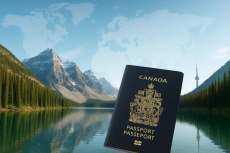Blog • Published on:November 20, 2025 | Updated on:November 20, 2025 • 11 Min
Where Can You Travel Visa-Free with a Thai Passport in 2025?
The Thai passport offers a wide range of travel options in 2025, especially across Asia, Europe, Latin America, and the Pacific. According to the latest data, Thai passport holders have visa-free, visa-on-arrival, and eVisa access to more than 80 countries and territories worldwide.
This gives Thailand a medium-ranked global mobility score, strong enough for easy regional travel and tourism, but still limited when it comes to North America, Schengen Europe, and several Middle Eastern destinations.
Thai travellers benefit from:
- Strong access within ASEAN
- Growing acceptance of eVisas
- Multiple visa exemptions in Asia and Europe
- Visa-free arrangements with Latin America and the Caribbean
However, traditional visas remain necessary for popular destinations such as:
- United States
- United Kingdom
- Schengen Area
- Australia and New Zealand
This guide breaks down exactly where Thai citizens can go and what type of entry permission is required, using the most recent and complete visa data.
What Should You Know About Thailand’s Passport Mobility in 2025?
Thailand’s passport strength comes from its regional integration, tourism-focused diplomacy, and the rapid expansion of digital visa systems.
While it does not rank among the world’s strongest passports, it provides reliable mobility across Asia, Europe (selected), Latin America, and the Pacific.
What Are the Key Mobility Facts for Thai Citizens?
- Visa-free destinations: Strong coverage across Asia, Europe (select countries), Latin America, and island states
- Visa-on-arrival: Widely available across Africa, the Middle East, Asia, and Oceania
- eVisa access: Growing rapidly, covering India, Turkey, Sri Lanka, several African nations, and more
- ASEAN mobility: Among the most generous regional travel frameworks globally
- Global ranking: Mid-range compared with major Asian passports but solid relative to developing nations
Why Does the Thai Passport Perform Well Regionally?
- ASEAN membership ensures smooth visa-free travel across Southeast Asia
- Tourism agreements expand access in Latin America and the Caribbean
- Digital visas make applications faster and easier
- Predictable travel policies across Asia support tourism and business travel
Where Are the Biggest Mobility Limitations?
Thai citizens still require visas for:
- North America (U.S. & Canada)
- Schengen Europe (full visa required)
- Australia and New Zealand
- Several Middle Eastern destinations
What Does This Mean for Thai Travellers?
- Travel within Asia is easy and flexible
- Long-haul travel often requires advance visa planning
- Frequent travellers may consider long-term or multiple-entry visas
- Digital visas continue to reduce bureaucracy
Which Countries Can Thai Citizens Visit Visa-Free in 2025?
Thai passport holders enjoy visa-free access across a wide geographic range, particularly in Asia, Latin America, Oceania, and parts of Europe.
The visa-free category offers the easiest form of travel: no prior application, no online form, and no arrival paperwork beyond standard immigration checks.
Below is the complete visa-free list for Thai passport holders.
*India requires an eVisa but offers it free of charge to Thai tourists, many Thai government sources still classify it as “visa-free”; however, for accuracy, it does involve an online pre-arrival application.
Key Notes for Travellers
- Some visa-free stays have specific duration limits (not listed here as requested).
- Entry rules may vary for biometric vs. non-biometric Thai passports (e.g., Japan).
- Several countries offer extensions upon request at local immigration offices.
- Always check airline requirements: some destinations may request onward travel proof even if the country itself does not.
Which Destinations Offer Visa-on-Arrival for Thai Citizens in 2025?
Visa-on-Arrival (VOA) destinations allow Thai travelers to obtain entry permission directly at the airport or border checkpoint, without completing the visa process in advance.
This makes travel flexible, especially for last-minute trips or regional mobility.
Below is the complete VOA list for Thai passport holders.
Notes for Travellers Using VOA
- Fees differ by country; many accept USD or card payments.
- Some countries may require yellow fever vaccination (e.g., East Africa).
- VOA queues can be long during peak seasons.
- Some states have airport-only VOA (e.g., Ethiopia, although eVisa preferred).
Which Countries Require an eVisa for Thai Citizens in 2025?
The number of destinations offering electronic visas for Thai citizens has expanded rapidly. eVisas allow travellers to apply online without visiting an embassy, making the process far easier than traditional visas.
Thai citizens benefit from eVisa systems across Africa, Asia, the Middle East, the Caribbean, and parts of Europe/Eurasia.
Below is the complete list of eVisa destinations for Thai citizens.
*India’s eVisa is free for Thai tourists, but still must be applied for online, so it is officially classified as eVisa, not visa-free.
Which Destinations Use Online eVisa Applications?
Thai citizens can apply digitally for:
- Middle Eastern countries: Saudi Arabia, Bahrain, Jordan, Iraq
- African states shifting to digital systems: Kenya, Ethiopia, Rwanda, Uganda
- Asian destinations with modern portals: India, Pakistan, Sri Lanka
- Eurasian countries: Azerbaijan, Armenia, Moldova, Uzbekistan
These systems allow biometrics, documents, and payment to be submitted online.
What Are the Processing Times and Validity Periods?
Processing times vary by country, but typical ranges include:
Processing Times
- Fast (24–72 hours): Kenya eTA, UAE Smart Service, Saudi eVisa
- Standard (3–7 days): India, Uzbekistan, Egypt, Moldova
- Extended (7–10+ days): Nigeria, Cameroon, Congo DR
Typical Validity
- Single-entry: 30–60 days
- Multiple-entry: 3 months to 1 year (varies by country)
- Entry methods: Most require entering through specific airports
Common Requirements
- Passport (6+ months validity)
- Passport photo (digital)
- Hotel confirmation or host invitation
- Return or onward ticket
- Credit/debit card for payment
Which Countries Require a Traditional Visa for Thai Citizens in 2025?
Even with broad visa-free, VOA, and eVisa access, Thai passport holders still need traditional embassy-issued visas for many destinations, especially in Europe, North America, and parts of Africa and the Middle East.
A traditional visa generally involves:
- Completing an online or paper application
- Submitting documents in person
- Providing biometrics
- Waiting days or weeks for processing
These visas apply mostly to high-demand destinations like Schengen Europe, the US, Canada, and the UK.
Below is the complete and final list of countries requiring a traditional visa for Thai passport holders.
* Countries with eVisa or VOA systems still require a traditional visa for full entry or in many cases unless specific exemptions apply.
How Does the Embassy Visa Application Process Work for Thai Travellers?
Most embassies follow similar steps:
1. Online pre-application
Includes form submission, document upload, and choosing an appointment date.
2. In-person appointment
Applicants must typically bring:
- Passport (6+ months validity)
- Photos
- Bank statements
- Travel itinerary
- Accommodation proof
- Invitation letters (for business/family visits)
3. Biometric submission
Fingerprints and photo for Schengen, UK, Canada, etc.
4. Wait for processing
Processing times vary widely.
How Far in Advance Should Thai Citizens Apply for a Visa?
Recommendation by destination:
Additional Tips
- Book appointments early, especially during holiday seasons.
- Ensure your passport has at least two blank pages for visas.
- Verify passport validity, many destinations require 6+ months.
What Travel Privileges Do Thai Citizens Have Within ASEAN?
Thailand’s membership in the Association of Southeast Asian Nations (ASEAN) gives Thai passport holders some of the strongest regional mobility rights in the world.
Within ASEAN, travel is extremely simple, fast, and predictable, ideal for tourism, work trips, education, and short-term stays.
Why ASEAN Mobility Is So Important for Thai Travellers
- No advance visa applications
- Smooth land, air, and sea borders
- Consistent entry policies across all ASEAN states
- Strong business, education, and labour mobility systems
- Multiple re-entry permitted
Thai citizens can visit all other nine ASEAN member states visa-free, making Southeast Asia one of the easiest regions to travel.
Which Southeast Asian Countries Can Thai Citizens Enter Easily?
Thai passport holders enjoy visa-free entry to all ASEAN nations:
Key Advantages for Thai Travellers
- Multiple entries allowed without special permits
- Perfect for cross-border business or short vacations
- Minimal paperwork (passport + onward ticket)
- Well-established immigration cooperation between Thailand and neighbouring states
ASEAN remains the backbone of Thailand’s travel freedom.
What ASEAN Travel Agreements Benefit Thai Passport Holders?
Thai citizens benefit from several formal ASEAN frameworks that simplify movement:
1. ASEAN Visa Exemption Arrangements
- Automatic visa-free entry for citizens of all ASEAN member states
- Harmonised border procedures across the region
- Ideal for business travellers and families visiting neighbouring countries
2. ASEAN Mutual Recognition Arrangements (MRAs)
These agreements make it easier for Thai professionals to work in ASEAN countries in fields such as:
- Engineering
- Nursing
- Architecture
- Tourism
- Surveying
- Accountancy
- Medical practitioners
3. ASEAN University Network (AUN) Mobility
- Smooth movement of students for exchange programs
- Reduced administrative requirements
- Simplified credit transfer policies
4. ASEAN Open Skies and Land Transport Agreements
- More flight options
- Predictable overland travel routes
- Reduced airline restrictions within the region
Why ASEAN Travel Is the Easiest for Thai Citizens
- Border checks are simple and efficient
- Policies are stable and rarely change
- ASEAN nationals often receive priority lanes at airports
- Both tourism and short-term business trips benefit
What Regional Travel Agreements Benefit Thai Citizens in 2025?
Thailand participates in several regional cooperation frameworks that expand travel flexibility for Thai passport holders.
These agreements improve mobility, streamline entry procedures, and often reduce administrative requirements for tourism, business, or transit.
Thai citizens benefit not only from ASEAN, but also from broader Asia–Pacific networks and bilateral agreements with key partner nations.
What Asia–Pacific Travel Privileges Do Thai Citizens Enjoy?
Beyond ASEAN, Thai travellers benefit from a range of Asia–Pacific arrangements that improve regional mobility:
1. Asia-Pacific Tourism Corridors
Several countries in East and Southeast Asia maintain tourism-focused partnerships with Thailand, allowing:
- Simplified arrival procedures
- Special short-stay entry privileges
- Reduced documentary requirements
Examples include:
- Japan (visa-free for 15 days with biometric passport)
- South Korea (K-ETA required, though entry for Thai nationals may be inconsistent)
- China (visa-free for selected stay periods)
2. APEC Cooperation (Limited Benefits for Thailand)
Although Thailand is an APEC member, Thai travellers do not receive the APEC Business Travel Card privileges, these apply only to designated countries.
Still, APEC membership facilitates:
- Faster diplomatic coordination
- Improved recognition of tourism and business mobility frameworks
- Streamlined future negotiations for expanded visa access
3. Regional eVisa Expansion
Asia–Pacific states have rapidly adopted eVisa systems that benefit Thai citizens, especially:
- India (free eVisa for Thai tourists)
- Sri Lanka (ETA system)
- Pakistan (free eVisa for Thais)
- Nepal (dual system: eVisa + VOA)
These digital systems reduce embassy dependency and speed up travel planning.
Which Bilateral Travel Arrangements Advantage Thai Passport Holders?
Countries with strong tourism or economic links to Thailand often offer preferential entry rules, including visa-free or simplified visas.
Notable Bilateral Arrangements Include:
- Russia – visa-free for Thai travellers
- Kazakhstan – visa-free
- Mongolia – visa-free
- Turkey – visa-free for 30 days
- Qatar – visa-free entry
- Oman – mixed visa-free/eVisa flexibility
- Georgia – visa-free for up to one year
Benefits of These Arrangements:
- Predictable immigration rules
- Long-standing diplomatic cooperation
- Better travel access than many non-ASEAN passports
- Encouragement of mutual tourism and investment
Why These Agreements Matter:
They help compensate for Thailand’s lack of visa-free access to Western regions such as:
- Schengen Europe
- North America
- Australia and New Zealand
These bilateral deals significantly expand Thailand’s global mobility footprint.
What Travel Considerations and Restrictions Should Thai Citizens Be Aware Of in 2025?
Even with wide visa-free, visa-on-arrival, and eVisa access, Thai passport holders must still follow several important travel rules and documentation requirements.
Entry conditions can differ significantly depending on region, immigration policies, and geopolitical developments.
Understanding these considerations helps ensure smooth travel, avoids delays at immigration, and prevents last-minute visa complications.
What Important Travel Documentation Do Thai Travellers Need?
Most countries, whether visa-free, VOA, or eVisa, require Thai citizens to carry certain documents before boarding or upon arrival.
Requirements vary, but the following list covers the essentials.
1. Passport Validity
- At least 6 months of validity beyond the arrival date is required in most countries.
- Some destinations also require two or more blank visa pages.
2. Proof of Onward or Return Travel
Airlines and immigration officers may request:
- A return ticket
- An onward ticket to a third country
- A confirmed itinerary
This is mandatory in several visa-free and VOA destinations.
3. Accommodation Confirmation
Travellers may need:
- Hotel reservations
- An invitation letter from a host
- Evidence of tour bookings
Especially common for VOA and eVisa countries.
4. Financial Proof
Some destinations require evidence of sufficient funds, such as:
- Bank statements
- Cash or credit availability
- Employer letter for business trips
5. Digital Pre-Registration
Some countries require travellers to complete:
- Electronic Travel Authorisations (eTA / ETA)
- Health declarations
- Immigration pre-arrival forms
Thai citizens enjoy a solid level of global mobility in 2025, with wide access to visa-free, visa-on-arrival, and eVisa destinations.
ASEAN remains the strongest and most seamless region for Thai travellers, while growing digital visa systems continue to expand convenience worldwide.
While long-haul travel to North America, Europe, or Oceania requires more preparation, Thai travellers still benefit from a diverse and expanding network of international entry options.
FAQs on Thailand’s Passport and Global Travel in 2025
How many countries can Thai citizens visit without a visa or with simplified entry in 2025?
Thai passport holders can access over 80 countries and territories through visa-free entry, visa-on-arrival, or eVisa systems. This number changes slightly each year based on bilateral agreements and digital visa reforms.
Do Thai citizens need a visa to visit Europe’s Schengen Area?
Yes. Thailand is not visa-exempt for Schengen entry. Thai travelers must apply for a Schengen short-stay visa (Type C) before departure, including biometrics, documentation, and an interview.
Can Thai passport holders travel to Japan without a visa?
Yes. Thai citizens with biometric passports can enter Japan for stays of up to 15 days visa-free. Older, non-biometric passports still require a visa.
Which major countries still require a full traditional visa for Thai travellers?
Key destinations that require a traditional embassy visa include the United States, Canada, United Kingdom, Australia, New Zealand, and all Schengen countries. These have stricter entry processes and longer processing times.
What documents should Thai travellers prepare for visa-free or VOA destinations?
Most countries require:
- A passport valid for 6+ months
- A return or onward ticket
- Proof of accommodation
- Sufficient financial resources
References
Wikipedia – Visa Requirements for Thai Citizens. Referred from: https://en.wikipedia.org/wiki/Visa_requirements_for_Thai_citizens
International Air Transport Association (IATA) – Travel Centre. Referred from: https://www.iatatravelcentre.com/
Ministry of Foreign Affairs of Thailand – Consular Services. Referred from: https://www.mfa.go.th
ASEAN Secretariat – ASEAN Visa Exemption and Mobility Framework. Referred from: https://asean.org
Asia-Pacific Economic Cooperation (APEC) – Regional Mobility and Travel Information. Referred from: https://www.apec.org
Written By

Andrew Wilder
Andrew Wilder is a multifaceted author on Business Migration programs all over the globe. Over the past 10 years, he has written extensively to help investors diversify their portfolios and gain citizenship or residency through innovative real estate and business investment opportunities.
Related Articles









Recently Published









Book a free consultation


